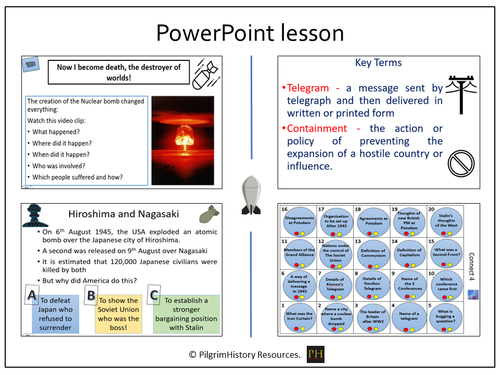



Superpower Relations and the Cold War, 1941-91
The lesson aims to explore the importance of the Kennan and Novikov Telegrams.
The context of the Telegrams is given at the start of the lesson, with students using video footage to explain the consequences if the atomic bomb was used.
Students will also learn of the recommendations each of the foreign ministers proposed to their respective superiors and the importance of their advise.
There is also a home learning challenge which the students can answer a key question and self assess themselves using a model answer.
The plenary make use of an interactive connect four game, complete with differentiated questions.
The lesson is enquiry based with a key question using a lightbulb posed at the start of the lesson and revisited throughout this and subsequent lessons to show the progress of learning.
The lessons in this bundle are therefore linked together to build up a picture of how diplomacy, propaganda and spying led two Superpowers with opposing political ideologies to create tensions, rivalries and distrust as well as subsequently forming mutual understanding and cooperation over the time period in question.
The resource includes retrieval practice, suggested teaching strategies, differentiated materials and GCSE question practice.
It also comes in PowerPoint format if there is a wish to adapt and change.
Something went wrong, please try again later.
This resource hasn't been reviewed yet
To ensure quality for our reviews, only customers who have purchased this resource can review it
Report this resourceto let us know if it violates our terms and conditions.
Our customer service team will review your report and will be in touch.